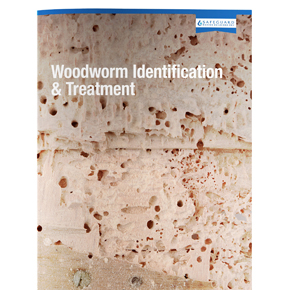
Listen to Safeguard and don’t let woodworm become a bugbear
Safeguard Europe has launched an incredibly useful guide which tackles the troublesome issue of larval infestation of timber; looking at how the cause can be accurately identified and the best solution to treating it.
A fair few species of ‘woodworm’ can be found in Britain; and for anybody associated with building maintenance or refurbishment, it is vital they can recognise them, as some woodworm can be more damaging that others.
The UK’s leading specialist in damp-proofing and waterproofing technology have introduced Woodworm Identification and Treatment. This guide is full of extensive colour photography, detailing the species you are likely to come across in the UK, from larvae to adult.
As well as identification, the publication also looks at what needs to be done to assess if a woodworm infestation is still active or has died out, and how to deal, long term, with small infestations of common species in an effective manner.
Some minor infestations can easily be dealt with by applying a high strength curative woodworm treatment, an example being Soluguard Woodworm Treatment.
However, there are others which will need a more in depth, extensive treatment by a professional company, with the recommendation they be a Property Care Association member.
The guide analyses a common confusion many people have; this is that ‘woodworms’ are worms and they are a damaging relation of the useful variety found in soil. In actual fact, woodworm are the wood-eating larvae, better known as maggots, of particular beetles.
The curative woodworm treatment method mentioned above sees the fluid applied to all surfaces of the affected timber. This kills adult beetles, which prevents them from reproducing.
However, it doesn’t kill larvae deeper than 2mm below the timber surface, so this type of surface treatment is only suitable for lighter infestations.
An important consideration when choosing woodworm treatment fluid is to differentiate between products tested under European Standards for either ‘curative’ or ‘preventative’ use – the latter use products of lower strength, meaning while new attacks on timber can be prevented, they cannot exterminate an existing infestation.
Heavier infestation, or those featuring more aggressive woodworm species, may require affected timber to be removed and replaced. Treatment with injected pastes or gels, like ProBor 20, could be used, as these have the ability to kill the larvae deep into the timber. NB- these are licensed by the HSE as only for professional use.
For a free copy of Safeguard’s Woodworm Identification and Treatment, visit www.safeguardeurope.com or email [email protected].
Contact:
Safeguard Europe,
Redkiln Close,
Horsham,
West Sussex,
United Kingdom,
RH13 5QL
Phone: 01403 210204
Fax: 01403 217529
Visit Safeguard Europe's website
Visit Supplier's page
Latest news

18th April 2024
Abloy UK showcases new digital portfolio at The Security Event 2024
Abloy UK is set to unveil its latest line-up of access control systems at The Security Event 2024, welcoming guests to explore its cutting-edge electromechanical and digital solutions on stand 5/F50.
Posted in Access Control & Door Entry Systems, Architectural Ironmongery, Articles, Building Industry Events, Building Industry News, Building Products & Structures, Building Services, Doors, Exhibitions and Conferences, Facility Management & Building Services, Health & Safety, Information Technology, Retrofit & Renovation, Security and Fire Protection
18th April 2024
Strand is a Failsafe Choice for Emergency Exit and Panic Hardware
In times of emergency, you’re in safe hands with Strand Hardware. Although there are many considerations for building specification, few decisions can be as critical as selecting the right emergency exit/panic hardware.
Posted in Access Control & Door Entry Systems, Architectural Ironmongery, Articles, Building Industry News, Building Products & Structures, Building Services, Doors, Facility Management & Building Services, Health & Safety, Restoration & Refurbishment, Retrofit & Renovation, Security and Fire Protection
18th April 2024
MRA appoints Callum Budd as Research Projects Director
MRA Research, the research agency focused solely on the construction sector, welcomes Callum Budd as its new Research Projects Director.
Posted in Articles, Building Industry News, Information Technology, news, Recruitment, Research & Materials Testing
16th April 2024
Mitsubishi Electric set to host CIBSE Journal webinar
Mitsubishi Electric will host a CIBSE Journal webinar on Wednesday 24th April 2024 at 1pm to discuss the legislation and initiatives driving changes in the way we will need to heat, cool and ventilate large commercial buildings to reach net zero emissions in the UK.
Posted in Air Conditioning, Articles, Building Industry Events, Building Industry News, Building Products & Structures, Building Regulations & Accreditations, Building Services, Facility Management & Building Services, Heating Systems, Controls and Management, Heating, Ventilation and Air Conditioning - HVAC, Information Technology, Pipes & Fittings, Plumbing, Seminars, Sustainability & Energy Efficiency, Training
 Sign up:
Sign up: